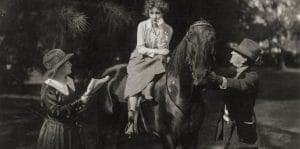
Pamela B. Green is a veteran in the film industry who wears many hats. From feature film main titles, motion graphics, creative directing, archiving, directing and producing, she has done it all. So it makes perfect sense that Green would be at the helm of a documentary about a similar woman, Alice Guy-Blaché. Madame Blaché, as she is referred to throughout most of Be Natural, was a pioneer in the film industry. Not only was she the first female film director, but she was also one of the first film directors…period. Yet for some reason, very few people outside of the film community know who she is, and even a lot of them don’t.
The beginning of this documentary covers the life and times of this forgotten heroine of cinema. There is a quick montage of filmmakers and producers, both men and women, and out of all of them, only screenwriter and producer Gale Ann Hurd and director Ava Duvernay had heard of her. Even Peter Bogdonavich who purportedly knows everything that there is to know about the history of cinema says “I’ve read a bunch of books about movies and written them, and I never heard her name.”

“She was incredibly innovative, and it’s a shame that for all the work she did, she died in relative obscurity.”
As Be Natural unfolds, we learn about Guy-Blaché’s life from childhood until her death in 1968. Simultaneously we join Green as she journeys to find out as much about Guy-Blaché and her films as she can. She speaks to relatives, long lost family friends, and film archivists all over the world. We learn about how Guy-Blaché was the first filmmaker for Gaumont Studios in France. She trained several men to write and direct as well, only for her films to later be credited to them.
We also learn about the Solax company, which Guy-Blaché started with her husband Herbert. It started in Flushing, New York, and then a bigger production studio was built in Fort Lee, New Jersey; which until watching this film, I had no idea was basically “Hollywood 1.0”. All the major studios were based out of this city until a Trust was started by the Edison company which required a large investment to be able to use their equipment, which was the best in the US at the time — thus causing people to venture out West to make films and the creation of Hollywood.

“I’ve read a bunch of books about movies and written them, and I never heard her name.”
Alice Guy-Blaché was one of the first directors to use color and to synch sound with the camera. She was also one of the first directors to direct a film with an all-black cast, A Fool And His Money starring James Russell. She was incredibly innovative, and it’s a shame that for all the work she did, she died in relative obscurity. She wrote her memoirs well before her death, and no one was interested in publishing them. They would eventually be published eight years after death.
Be Natural: The Untold Story of Alice Guy-Blaché is essential viewing for those who want a complete perspective on the history of film. Tons of information is packed into an hour and thirty-seven minutes and much of it I didn’t know before watching. There’s a cavalcade of talking heads in this film that goes from the top film historians to A-list actors. There’s a re-enactment of one of her films used on the same camera she used starring Chris Kattan and Horatio Sanz! It’s also narrated by Jodie Foster! There is so much more to learn from the film from the few details I’ve mentioned here. Please view Be Natural (which comes from a sign in the Solax building that Guy-Blaché put on the wall for the actors) to give Madame Blaché the recognition she so richly deserved in life. Thanks to Pamela B. Green for her painstaking efforts. This is a must-watch documentary!

Be Natural: The Untold Story of Alice Guy-Blaché (2019) Directed by Pamela B. Green. Written by Pamela B. Green and Joan Simon. Based on the book Alice Guy-Blaché: Lost Visionary of The Cinema by Alison Macmahan. Narrated by Jodie Foster.
8 out of 10 stars

